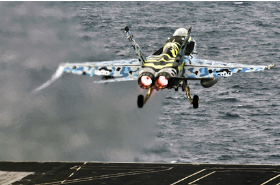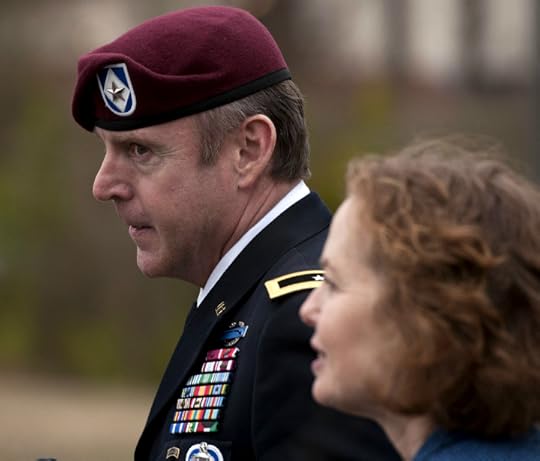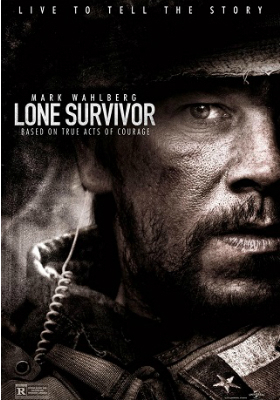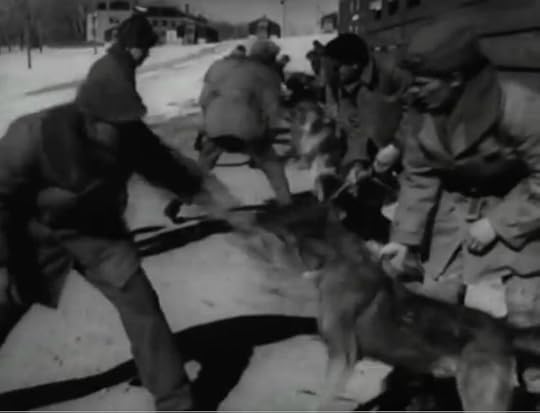Thomas E. Ricks's Blog, page 54
March 26, 2014
Obama taunts Putin: Weak-ass punk

I
think that President Obama is fundamentally correct in saying the obvious, that
Putin's Russia is no longer a superpower. He stood outside Putin's apartment house
yesterday and yelled up, "Russia is a regional power that is
threatening some of its immediate neighbors, not out of strength but out of weakness."
That
said, weak players can still punch strong players in the nose, if they are more
willing to take the pain than the big guy is. For more on this, see LBJ,
1964-1968.
March 25, 2014
'Proceedings' carries an article on aircraft carriers that comes close to self-parody

The February issue of Proceedings
carries a very poor cover article by an
admiral that says that aircraft carriers are well worth their $15 billion
pricetag. Why? Well, pretty much because he says so, dammit. He makes no real
effort to engage the critics and respond to their spate of recent criticism.
Look, it is fine to argue in favor of carriers. I just think that
to be intellectually honest, you need to look at today's huge flattops in the
context of the advent of the UCAV and of global satellite coverage. The
headline on the cover of the magazine is "CARRIERS: Cost Effective and
Crucial." That strikes me as a direct repudiation of the article by Navy Capt.
Harry Hendrix that was published last year by CNAS. Hendrix
argued that the carrier as we know it is rapidly becoming the battleship of our
time, seen as powerful yet actually surprisingly irrelevant -- and quite
expensive. But the article doesn't mention Hendrix's work. So instead of being
a professional discussion -- the ostensible
role of Proceedings -- it falls into
the realm of service propaganda.
By leading with weak, uninformative articles like this, Proceedings runs the risk of further
marginalizing itself. In this budget environment, you can't simply ignore those
who make cost-based arguments, or attack them for doing so.
Hmm. Bob Work, who is nominated to become deputy secretary of defense,
was head of CNAS when Capt. Hendrix's article was published. I wonder if the
Navy did this to fire a shot across his bow.
FoW (No. 21): To succeed, we need to act less like dinosaurs and more like bacteria

By
Matthew McClure
Best Defense future of war essay entrant
The most successful organisms
in Earth's history are simple enough to evolve quickly in response to their
environment. Dinosaurs, mammoths, and great civilizations all fall, but
bacteria evolves and outlasts. Bacteria proved this resilience through the ages
because of an evolutionary pace greater than its threats. Like bacteria, the
future of war belongs to those who can evolve or iterate faster than their
enemies.
Like watching bacteria in a
petri dish, we witnessed this evolution in the fight against IEDs. The first
IEDs used wireless detonators so we built jammers. They iterated and deployed a
dozen new ways to explode. We created a $1 billion JIEDDO program office,
waited a few years, and then deployed MRAPs. In that time, the diversity of IEDs
grew large and varied through hundreds of generational iterations. For every
one counter-IED system, the enemy deployed dozens of new bombs. Our enemy
learned and we were out-iterated.
But it's not the IED,
consumer electronics, or even the Internet. It's how all of these enable
iteration. Want a rat-bomb? Cough up the small cash for a 3D printer ($2800),
add a Raspberry Pi micro controller ($35), hit up GitHub, and iterate until it
works. When they learn how to stop them, print something just different enough
and try again. Better yet, print 1000 different types of Varmint Based
Munitions (VBM) and see which survive and let that design reproduce. But I hope
we remember it wasn't the rat, but bacteria that killed half of Europe. For the
future, look to the technologies that enable rapid, bacteria-like evolution. 3D
printing, programmable microcontrollers, and open, crowdsourced software
projects are just a few examples that let our enemies field hundreds of
disparate systems faster than we can draft a single requirements document.
To make things worse for the
United States, an enemy capable of rapid iteration is even more lethal against
a monolithic bureaucracy. The multi-year program of record and the master
technology plan are pointless. While we pour billions and years to create a
single-use, one-time hypersonic demo, the enemy is iterating through hundreds
of directed energy counters. Tomorrow's winners will have iterated through many
ideas faster than the losing bureaucracy with its zealous faith in the singular
approach.
Trying many ideas fast is how
my side of the generational gap works, and if you want to know what the world
of tomorrow brings look at the kids. Fueled by XBox and PlayStation,
we iterate through millions of hours of military tactics before the ink dries
on the first War College essay. Our data are collected, aggregated, and
scrutinized by millions of players around the world before that essay gets
through peer review. By the time it's published to the like-minded, we're
already on to the next war.
King of the jungle is
appealing, but will never outlast the king of the petri dish. Throughout the
eons of Earth's history, the simple and evolutionarily quick bacteria always
defeat the large predator. Similarly, wars of tomorrow will go to
those able to out-iterate their enemies.
But we can keep pace and even
thrive if we free the power of individual creativity from the chains of
bureaucratic process. Enable a diverse pool of researchers, combat veterans,
engineers, and even artists from every background and discipline with the tools
of iteration. Give them a problem and get out of their way. We all evolve when
they fearlessly pursue failure and then try, try again.
Matthew McClure is an
engineer and defense consultant. Before that, he spent 10 years in the Air
Force Research Laboratory playing video games and trying to move Title X
Wargaming into the 21st century. He is also a damn millennial.
Tom note: Why
not share a spoonful from your own petri dish on the future of war?
Consider submitting an essay
. The contest remains open for at least another few weeks.
Try to keep it short -- no more than 750 words, if possible. And please, no
footnotes or recycled war college papers.
'The Square': A great political film

The other night I cooked green chili chicken and my wife said we
should watch The Square, so of course we did.
It is a documentary about the continuing Egyptian revolution, and
no matter what your views, or even if you care, it is worth watching. Not only
does it tell you more about what is happening in Cairo, it is a great study of
how revolutions unfold, and cannibalize themselves. One of my kids said it reminded
her of Battle of Algiers -- which of course is one of the Best Defense 10 top
war films of all time.
March 24, 2014
The Sinclair sentence: I've calmed down enough to assess some of the damage

By Shelly Burgoyne
Best Defense guest
commenter
At
first I was just too angry, actually viscerally angry to offer anything
helpful, let alone insightful.
After a few
days I have calmed down a bit. I am still shocked at the judge's wounding
verdict, but I have been able to sift through all the garbage this Sinclair case produced and narrow down exactly why I am so affected, and it is
what I keep coming back to. It is what haunts me.
Gen. Sinclair admitted to serious crimes, crimes he has surely convicted others
(enlisted) of. He has surely docked pay from those under his command in
aggregate. He has surely convicted soldiers and thrown them in Leavenworth,
kicked out soldiers, etc. for crimes far less than his -- far less.
He admitted
to breaking the law over and over and yet he was deemed honorable by this judge
-- honorable! It is as if our Army has transformed into some kind of a gang, a
completely illegitimate organization. I am humiliated and insulted beyond
return.
His family is innocent in this, but that is not a reason to allow this admitted
criminal to retire with honor and keep taxpayers' money, his pension. A
military pension is entitled to the servicemember; the pension is his, not his
wife's. I am a military wife, but I also served and the combat veteran in me
knows the judge should have taken it. How many families of enlisted soldiers
have been left destitute after breaking laws far less severely than Gen. Sinclair?
Finally, the
incredible damage that this one criminal has left in his wake of toxicity and dysfunction will change the Army
forever. Senators and congressmen on the fence chose a side yesterday and it
wasn't the Army's side. Congress will proceed to tear
apart our laws and our command authority, and I no longer care much that they do.
Ms. Burgoyne is a former Army officer.
She served combat tours to Iraq in 2003 and 2005. She was named a Tillman
Scholar in 2010 and recently completed her graduate studies at the University
of Maryland. She is currently living and writing in the D.C. area, where her
work focuses on veterans and women in the military.
Following the money through war movies tells us what the American audience wants

By Jim
Gourley
Best
Defense bureau chief for American culture
Lone Survivor is winding down after a comparatively stellar
10-week run in theaters. It will leave the box office with a decent set of
achievements. In addition to its Screen Actors Guild Award for best stunt
ensemble, it will be remembered as having the second-best opening weekend for a
film released in January, and earned more money than any war film since 9/11.
It's poised to exceed $125 million in sales before it departs the big screen.
For all its action and effects, the film's producers and actors insisted that
the film's story was the most important element. Actor Mark Wahlberg
passionately discussed the message of service and sacrifice within the movie's
retelling of the ill-fated Operation Redwings. He and many others believed that
the film would succeed not only because it was a true story, but a genuine one.
There is another explanation for its success,
however, and it happens to carry its own message. Trends strongly suggest a
formula for a successful Hollywood war film -- its first commandment being to
sell it to Americans. As of March 17, Lone
Survivor has earned $142,196,271 globally. Only $17,600,000 of that has come
from theaters outside the United States and Canada. With 87.7 percent of the
ticket sales coming from domestic movie-goers, it earns another box office
accolade: most lopsided in audience interest. The former top-grossing war film,
2009's Brothers, picked up 34.1
percent of its $43.3 million take from Europe. While not considered a war film,
the Kathryn Bigelow-helmed Zero Dark
Thirty made 72.1 percent of its money from American audiences. Were it
included in the genre, it would be the top-grossing entry with a $132.8 million
box office haul.
The nuances of what makes a film a war movie or not
aside, their dependence on American ticket sales for success is highlighted by
just how badly they fare in overall revenue if they earn a greater percentage
in Europe. Bigelow's bonafide war film The
Hurt Locker took 65.4 percent of its earnings from the foreign box office.
Despite winning nine Academy Awards, including Best Picture, it only made $49.2
million. By contrast, consider the earnings of the critically-panned Act of Valor, which raked in $81.2
million, 86.1 percent of which came from the United States.
That leads to the second indicated "rule"
of making financially successful war films: The messiest parts ought to involve
blood and guts rather than philosophy and politics. It's arguable that the
moral weight of Clint Eastwood's Sands of
Iwo Jima and its companion film, Flags
of Our Fathers, with a domestic/foreign split closer to 50 percent, held
revenues down below the $70 million mark. Though the ethical wrangling of Lions for Lambs overwhelmingly appealed
to foreign patrons, the Robert Redford-directed and -led film only took in $63
million. The same applies to Green Zone,
a conspiracy-in-the-ranks story that made a respectable $94.8 million but still
ranks as one of Matt Damon's lowest-earning films.
It seems reasonable to draw a conclusion based on
two distinct yet iconic scenes in contemporary war films: When James Caviezel
and Sean Penn riddle each other with transcendental poetry, The Thin Red Line makes $98 million on
largely European audiences, but when Eric Bana asks Josh Hartnett, "You
know what I think?" and then answers himself with, "It don't matter
what I think," the demographics flip and Black Hawk Down reaps $172 million.
In short, American audiences appear to still
embrace the John Wayne tradition. They can handle the death and heartbreak
caused by war, but those burdens must be shouldered by the hero. Any suggestion
that the audience, in its role as the society that sends the hero off to war,
bears some of the responsibility for the war's existence in the first place
risks losing their enthusiasm for the enterprise on which the entire film is
based. In other words, Americans want entertainment, not a lecture. Europeans
seem to be more open to explorations of human nature.
Following the money leads one to conclude that
there are stark differences between American and European interests in war
films, in terms of both level and taste. What it says about American and
European differences regarding war itself bears consideration. It's no secret
that the international community has been sharply divided on many aspects of
the real wars of the 21st century thus far. Observing what they prefer in their
fictional wars may indicate the perceptions driving the disagreements.
It bears remarking that there are exceptions to the
rule. Both Schindler's List and Saving Private Ryan made over $300
million and $200 million, respectively, and on a European majority audience. War Horse was closer to an even balance
and topped $177 million. Of course, the common denominator of all three films
is someone named Steven Spielberg, whose legendary reputation and career mean
he can work on a set of rules all their own.
Perhaps the biggest break with the conventional
wisdom is Mel Gibson's We Were Soldiers.
The Vietnam-based film touched several political and socio-cultural third rails
with regard to that conflict and the proposition of war in general. It still filled
the seats with an American majority and earned $114 million. And finally, there
is perhaps that most spiritually numbing narrative on the cost of war, the 1946
Best Picture winner The Best Years of Our
Lives. It made 52 percent of its money from European moviegoers (most of
those British), finishing with an estimated $23.6 million, which adjusted for
today's dollars would be $459.2 million. Perhaps its egalitarian appeal and
great success puts modern regional attitudes into historical perspective. It is
difficult to believe a modern remake based on current conflicts could repeat
the original's triumph.
Hey, the QDR left out PME! How come?

By Nicholas Murray
Best Defense guest columnist
"The only thing that
we can actually guarantee is that in the future we're going to have to have
very well-developed leaders that can lead in very ambiguous situations and very
challenging situations and can really pull a team together to do very difficult
things with maybe not a lot of time to think about it or a lot of guidance
ahead of time." -- Lt. Gen. David Perkins, speaking to a group of
students at the Maneuver Captains Career Course at Fort Benning, June 25, 2013
Lt. Gen. Perkins is spot on. To create the leaders he is talking about
logically requires a first-class military education system. Yet the new QDR hardly mentions it. In times of declining budgets one of the key things
armed forces have done historically to enable continued success or to reform
after failure, has been to focus on the education of their future leaders. This
has proven time and again to be a cost-effective combat multiplier for armed
forces. Indeed, the role of education is prominent in the previous two QDRs
(2010 and 2006), yet it is mentioned only in passing in the current version.
Given all of the arguments of the last few years over the state of
military education, it should continue to feature prominently. Yet this is not
the case. The current QDR does recognize the need to develop service leaders
when it states: "Above all, we will need to invest more in finding and
developing leaders of consequence at every level, men and women of both
competence and character." Clearly, then, the failure to discuss the role of education
in the preparation of service personnel to meet an uncertain future is an
oversight (whether deliberate or not). If it was deliberate, it implies that
education is not considered important to the future preparation of the services.
Alternatively, it was a curious error.
So, what should the services do about this? After all, many senior service
leaders have identified high quality education as a crucial component in the
development of the type of critical-thinking adaptive leaders the services will
almost certainly need. To that end, a thorough review is needed of the quality
and output of the services' education systems, along with an analysis of where
military education fits in with the country's national security strategy over
the longer term.
To facilitate the process, this author has four main suggestions:
1) Clearly identify and describe the purpose of military education writ
large.
2) Create an overarching education policy for the services as a whole,
one that leaves room for the needs of the individual services.
3) Identify what programs are in place right now, or are being
implemented, to address the criticisms of military education regarding its
quality and the development of adaptive strategic-minded critical-thinkers.
4) Have military education monitored by an external committee who report
directly to the OSD (P&R).
Once the above has been accomplished, the services will have a better
grip on what needs to be done to educate its servicemen and -women to meet
requirements (whatever they might be), why it needs to do them, as well as how
well it is actually doing.
Dr. Nicholas Murray is an associate
professor in the Department of Military History at the U.S. Army Command and
Staff College. He is the current Educator of the Year for History at CGSC, and
recently received the Department of the Army's Commander's Award for Civilian
Service. His book The Rocky Road to the Great War
(Potomac Books) came out last year. He recently published "The Role of Professional Military Education in Mission Command" in Joint Forces
Quarterly. This article represents his own views and unless otherwise stated
does not necessarily represent those of the CGSC, the U.S. Army, or the Defense
Department.
March 21, 2014
The future of war (no. 20) scares me -- and underscores the importance of resiliency

By Puong Fei Yeh
Best Defense
future of war contest entrant
The future of war
scares me.
It scares me the
most when I think about the world we live in -- the long-standing threat of
nuclear weapons and proliferation, the rise of unmanned combat platforms, cyber
weapons, and not-yet-invented or imagined ways to conduct war. Some of the
earlier posts in this blog have touched on the inviolate laws of war, and
therefore what we can expect war to look like in the future, but if there is
one law that gives me pause it is the power law of war.
I'm not referring to
the capacity of countries or groups to wage war, but rather Lewis Fry Richardson's insight in 1948 that wars exhibit a power
law relationship.
Richardson
discovered that the magnitude of wars as measured in how many people die is
inversely proportional to the frequency with which those wars occur along a
smooth curve. At one extreme end of the scale are the First and Second World
Wars, in which tens of millions of people were killed, and at the other end of
the spectrum are greater numbers of conflicts in which the number of
causalities range from tens of thousands to hundreds of thousands. Conflicts
like the Vietnam War (1965), Iran-Iraq War (1980), and the Taiping Rebellion
(1850) lie in the upper range of the curve. Since Richardson's discovery,
scholars have duplicated his results using larger datasets and subsets of
conflict-related data, including fatalities attributed to terrorism. Power law
explains a diverse range of natural and human phenomenon, from the magnitudes
and frequency of earthquakes to the population of cities.
Are we (or our kids)
due for a high magnitude event? One of the most frustrating things about
Richardson's discovery is the complete lack of predicative power. Simply put,
power law is nice, but as many others have pointed out, so what? Knowing in the
aggregate that a lot of people die in a few wars and not as many in many more
wars doesn't help us plan for the future. Although that's true, I believe
Richardson's insight is useful in providing some perspective and humility about
the future, both near- and long-term. First, wars will continue: People, in
large numbers, will continue to die. Second, the unthinkable -- the risk of
another world war or even a more localized, regional war -- should not be
unimaginable. Power law suggests events of intense severity will occur more
often than random chance. Unfortunately, we lack of a good sense of where we
lie on the curve.
So whether we think
the next big one is an all-out war between China and the United States, a
global cyberwar, a regional nuclear war between India and Pakistan, or a
terrorist organization detonating a nuke in one of the world's top 10 cities,
managing the risk that stems from any of these wars occurring is just as
important as reducing the risk that these deadly conflicts will start.
Borrowing from Nassim Taleb's theme of antifragile and other works on
resiliency, what series of steps can we begin to take to mold our system today
-- political, military, economic, and social institutions -- to withstand
devastating shocks? Ideally, you'd like to take a series of short-term steps
towards solving what is hopefully a long-term problem, because if you don't,
you're screwed when the high-magnitude event arrives.
If I'm going to make
a bet on the future of war, I will bet on the country that is most adaptive and
most resilient as the one to survive and prevail through the next series of
shocks.
Puong Fei Yeh is an
analyst at the Department of Defense, specializing in WMD and arms
proliferation. The views expressed here are his own and do not reflect the
official policy or position of the Department of the Defense or the U.S. government.
Tom note:
You're smart, you can do things. When you get back from taking Michael to the
airport, why not jot down your own views of the future of war?
Consider submitting an essay
. The contest remains open for at least another few weeks.
Try to keep it short -- no more than 750 words, if possible. And please, no
footnotes or recycled war college papers.
The Best Defense award for new national security blog goes to 'War on the Rocks'

At a
time when a lot of defense blogs are fading away like old soldiers, it is nice
to see a new one launched and doing nicely. In awarding "best new national
security blog" to "War on the Rocks," our judge (me) cited it as
consistently readable and thoughtful. Here is a nice item it had the other day on fiction about war.
And as
long as we are on the subject, here is Adrian Bonenberger's list of the 10 best contemporary war novels.
Also,
here is a good article from Washington's City
Paper by Rob Kunzig about the lives of young vets in D.C.
I've
bought Phil Klay's Redeployment, but haven't yet started it, in
part because I am wary of diving back into Iraq issues, but also because my
current pleasure reading is Count Basie's autobiography, which is fun but long.
(Hat tip to Deb Cummins)
Rebecca's War Dog of the Week: War Bulletin from 1943 Nails the 'Use of War Dogs'

By Rebecca Frankel
Best Defense Chief Canine Correspondent
This gem of a Friday flashback
find is a short film produced by the War Department (U.S. Army) in 1943 --
"The Use of War Dogs." The 12 minute bulletin -- now declassified -- takes
viewers on a tour of all the many uses of dogs in war, from messenger dogs to "silent"
scout dogs to casualty dogs.
The film has all the grist and
glory of a 1940s production -- the narrator sounds a little like a two-bit
gangster and the music sounds as if it were from a hybrid soundtrack of The Three Stooges and old episodes of Lassie, but whoever made this film
really understood how important military dogs were to their troops fighting the
war.
As the narrator proclaims early on while detailing the work of one dog:
"it would be the same in frozen wastes or hot jungles, in any kind of
weather or field conditions. The silent scout dog handles his assignment with
trained efficiency."
The film was made in 1943, only
about one year after dogs were officially inducted into military service as a fighting
force, which gives you a sense of how very quickly these animals were deemed
indispensable. Though you can also tells it's early in the war effort and the
military hadn't quite settled on standard MWD practice. You can still see a
host of different breeds (that they would ultimately cull) and some of the jobs
they showed still had one foot -- or paw -- back in WW I.
But you can also see that some methods of training are still employed (at least
in part) today. For example, they went to great lengths to simulate the chaos
and intensity of the front lines. (Check out around 6:06 where the dog is
running through and around multiple explosions and, as the narrator points out,
"stays the course.")
There was one line that caught
me -- a line thick with layers, especially when you hold it up against war-dog
history and the tendency at the end of wars to shrink military dogs programs
until we lose their readiness and, even worse, their capabilities. We watch a
dog finish his task only to pick up an impromptu one -- the dog's natural
ability and loyalty prevailing to save the day. The narrator's voice comes on:
"Now that you've seen it," he says, as if speaking to a crowd of
war-dog naysayers, "the whole thing appears so obvious."
Doesn't it, though?
Hat Tip: U.S. War Dogs
Association Facebook page via P. Winds
Thomas E. Ricks's Blog
- Thomas E. Ricks's profile
- 437 followers



